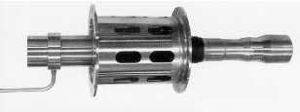
Home - Search - Browse - Alphabetic Index: 0- 1- 2- 3- 4- 5- 6- 7- 8- 9
A- B- C- D- E- F- G- H- I- J- K- L- M- N- O- P- Q- R- S- T- U- V- W- X- Y- Z
ESEX Arcjet
 Esex Arcjet |
Status: In Production. Thrust: 2.00 N (0.40 lbf). Specific impulse: 800 s.
The ESEX (Electric Propulsion Space Experiment) program began in 1989 under the then Air Force Astronautics Lab, Edwards AFB, CA. The prime contractor was TRW, Space Park, Redondo Beach, CA. The Arcject was build by Rocket Research (now Aerojet), Redmond, WA. The ESEX experiment flew once in 1999 on board the ARGOS satellite. The ARGOS satellite was built by Space & Missile system Center (SMC), Los Angeles AFB, CA under the program P-91-1. ARGOS carried 8 other DoD space experiments to orbit.
ESEX was the first High Power Electric Propulsion flight. The system operated on 30 kW with about 26 kW to the thruster. The experiment was powered by 205 kg of silver zinc batteries built by Eagle Pitcher Company of Joplin, Mo. At the time this was the highest power subsystem ever flown in space.
The objective was to verify Arcjet performance in space and determine if any spacecraft compatibility or contamination issues existed. AGROS operated with no detectable impact when the thruster operating. Sensors detected no RF interference, no increase in contamination, and measurements of specific impulse and thrust were within ground measurement uncertainty.
This truly pioneering flight program gave the satellite community great confidence in using High Power Electric propulsion. The ammonia fuel was fed at 0.25mg/sec steady state. Design life of the engine was 1500 hours and 400 on/off cycles.
Country: USA. Spacecraft: ARGOS. Propellants: Electric/Ammonia. Agency: Redmond.
Back to top of page
Home - Search - Browse - Alphabetic Index: 0- 1- 2- 3- 4- 5- 6- 7- 8- 9
A- B- C- D- E- F- G- H- I- J- K- L- M- N- O- P- Q- R- S- T- U- V- W- X- Y- Z
© 1997-2019 Mark Wade - Contact
© / Conditions for Use